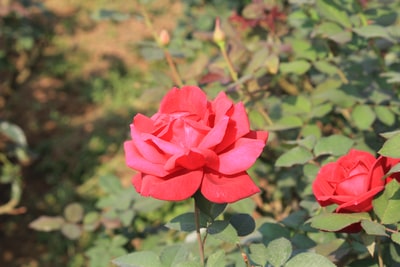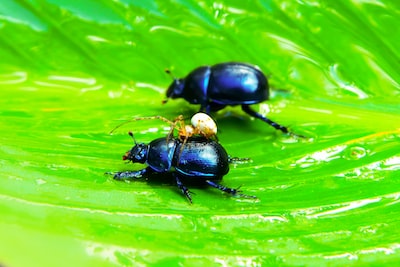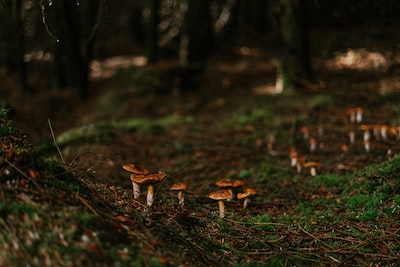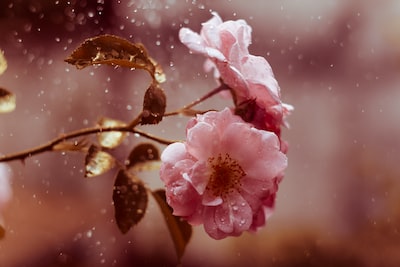In the serene and picturesque world of gardening, roses are considered the crown jewels of the floral kingdom. With their vibrant colors, velvety texture, and alluring fragrance, they can transform any garden into an enchanting paradise.
However, often overlooked and underestimated, is the devious and damaging presence of pests like Aphids. These minuscule, sap-sucking insects can wreak havoc on your rose bushes, leaving them withered, unattractive, and vulnerable to disease.
As gardeners, we must not only tend to the delicate beauty of our roses, but also expertly navigate the treacherous world of pest infestations. So, what can go wrong with roses and how can we protect them from the relentless grasp of Aphids? The answer lies in the delicate balance of knowledge, strategy, and perseverance in the face of adversity.
Caterpillars are a common pest that can plague rose gardens, but they are just one of the potential problems that growers may face. The delicate blossoms of roses are prized for their beauty and fragrance, but they also require a great deal of care and attention to thrive.
From fungal diseases to insect infestations, there are a multitude of threats that can damage or even kill rose bushes. In some cases, the problems may be caused by poor growing conditions, such as inadequate soil drainage or too much sun exposure.
Other times, it may simply be a matter of bad luck – one severe storm or unexpected frost can wipe out an entire crop of roses. Despite these challenges, many gardeners still find joy in growing roses, and there are a variety of techniques and tools available to help mitigate the risks.
However, it’s important for growers to remain vigilant and proactive in their efforts to protect these delicate plants. By staying informed about the latest research and best practices, and by working with experienced horticulturists and fellow enthusiasts, rose gardeners can help ensure that their blooms continue to flourish for years to come.
Whether you’re a novice or an expert, there’s always something new to learn about the fascinating and sometimes vexing world of rose cultivation. So get out there, get your hands dirty, and don’t let those pesky caterpillars get you down!
Table of Contents
1. Introduction
Roses are a classic symbol of love and beauty, but growing them can be challenging. Gardeners have been perfecting the art of rose growing for centuries, but problems can still arise.
The tiny but formidable aphid is a major threat to rose plants, consuming their sap and leaving them sickly. Other potential issues include fungal diseases, lack of sunlight, improper soil conditions, and harsh weather.
Despite these challenges, roses are still beloved for their unmatched beauty and fragrance. Successful rose gardening is truly satisfying, whether you’re a pro or a novice.
There’s always something new to learn about growing roses, so grab your pruning shears and potting soil and explore the world of rose growing!
2. Disease
Roses are popular among gardeners thanks to their varied hues and lovely scent. But they can be fussy to grow and maintain, with disease being a common problem.
These diseases can range from mild to severe, and can cause spotting on leaves and stems – and they’re caused by bacteria, viruses, or fungi. Nutrient deficiencies can also cause issues, leading to weakened plants that are more susceptible to infections, black spot being a typical example.
Properly inspecting your roses regularly and taking appropriate measures – pruning, adding fungicides or fertilizers – will help maintain their health and beauty. Despite the difficulties, the effort to grow roses is worthwhile.
3. Pest infestation
Growing roses brings both beauty and challenges. A major issue for rose lovers is the damage caused by pests like aphids and Japanese beetles.
Proper watering is also a delicate balance between providing just enough for healthy blooms and avoiding root rot from overwatering. Despite these challenges, gardeners find great joy in nurturing roses to their fullest potential.
The reward of watching delicate blooms unfold and fill the air with sweet fragrance is worth the effort of constant attention and care. With proper care, a rose garden can provide years of beauty and enjoyment.
4. Soil problems
Gardening enthusiasts know that roses are one of the most popular flowers, but growing them can be tricky. Soil problems are a big obstacle for rose growers.
Roses need a fertile, well-draining soil with essential nutrients. If the soil lacks these or gets too wet, it can lead to issues like the common affliction, ”Black Spot.
” Gardeners who put a lot of love and effort into their rose beds can be disheartened to see their leaves turn yellow and fall off. To reduce soil-related problems like Black Spot, it’s important to balance the soil with organic matter and avoid overcrowding and overwatering.
Soil science is complex, and even experienced gardeners can be confounded. Seek advice from professionals to navigate these potential issues if you’re considering growing roses.
5. Flower distortion
Roses are beautiful with their stunning hues and delicate layers of petals. However, these magnificent flowers are vulnerable to pests, diseases, and environmental stressors.
One common problem for gardeners is flower distortion, which results in misshapen petals, color changes, and uneven growth patterns. The culprits of flower distortion can range from fungal diseases to nutrient imbalances.
Scale insects can also lead to deformed flowers by sucking the sap out of roses and leaving behind a sticky residue that attracts other pests. Therefore, proper pruning, fertilization, watering, and monitoring for signs of disease or pest infestation are crucial to prevent the issue.
Sometimes, chemical treatments or biological control methods may be necessary, but careful attention must be given to not harm beneficial insects that can aid in pollination and protect roses from further attacks. Growing roses can be rewarding, but it requires patience, knowledge, and attention to detail.
6. Nutrient imbalance
Growing roses has become increasingly popular in recent years, but they can come with potential issues. One such issue is nutrient imbalances caused by inconsistent or excessive fertilization.
A lack of nitrogen can reduce bloom quality and quantity, while excessive phosphate can weaken stems and foliage. Pest infestations can also occur, with thrips being the most damaging.
These tiny insects can cause wilting, streaking, and discolored blooms that hinder rose bush growth. Dealing with these problems can frustrate gardeners but a professional with a plan can help.
Growing roses can be a labor of love for garden enthusiasts who handle them correctly.
7. Environmental stress
When envisioning an ideal garden, one may picture the colorful blossoms and sweet fragrances of roses. However, roses pose potential issues for gardeners.
Environmental stress is a particularly worrisome problem, as it can lead to severe damage to rose plants. This stress can manifest in various forms, such as drought, extreme temperatures, pests, and diseases.
Among these pests are the notorious red spider mites, which may be small in size but can wreak havoc on roses, rendering them weak and prone to further stress. Their presence often points to pre-existing environmental stress that has already weakened the plants.
Combating environmental stress and pest infestation may require a thoughtful approach including strategic planting, routine upkeep, and expert guidance. But achieving a healthy and radiant rose garden is worth the investment.
8. Improper pruning
Rose cultivation is a beloved hobby for many gardeners, but it can present a host of challenges. One common problem is improper pruning, which can have negative effects on the plant’s health and appearance.
Poor pruning can create open wounds and stubs that insects and disease can easily infest, including powdery mildew, a fungal disease that leaves a white powdery coating on leaves and causes stunted growth. Incorrect pruning can also result in unattractive foliage and uneven growth patterns.
To prevent these issues, gardeners should use proper timing, tools, and attention to detail when pruning. This ensures healthy and beautiful roses that delight visitors and gardeners alike.
9. Fungal infections
Roses are a popular feature of many gardens worldwide, but they can be vulnerable to fungal infections like rust. Rust causes orange or rust-colored spots on the leaf undersides, petals, and sepals, and can harm the plant’s health and aesthetic appeal.
Lack of sunlight, inadequate watering, and poor air circulation are common causes of rust in roses. Additionally, rust spores can spread quickly in damp and humid conditions, making control difficult.
To prevent rust infestations, gardeners should improve air circulation through regular pruning, remove infected leaves, and enhance watering and fertilizing regimes. Alternatively, they can use natural fungicides or rust-resistant rose varieties to combat this disease.
Despite their high-maintenance requirements, roses remain a cherished symbol of love, passion, and beauty. With patience and diligence, gardeners can ensure these beautiful plants flourish and mesmerize us for years to come.
10. Climate
Climate change has impacted once-luxurious gardens and made it challenging for gardeners to cultivate roses. Factors like temperature, rainfall, and humidity affect the growth of roses and unpredictable weather conditions can cause significant damage to these beloved flowers.
Pests, especially caterpillars, can be destructive too. Gardeners must stay vigilant and adapt to innovate and overcome challenges to cultivate the roses they love.
Although challenging, the stunning beauty of blooming roses is worth the effort.
11. Rose rosette virus
Growing roses is an art that has graced gardens and homes for centuries. But, the rose rosette virus is a disease wreaking havoc on rose gardens in North America.
Spread unknowingly by tiny mites, it has caused an uproar in the horticultural community. New growth appears stunted and distorted, foliage becomes reddish purple, and stems develop an unusual thickness resembling a soft brush.
Scientists and breeders are trying to combat it, but there is currently no cure. The only way to rid an infected rose is to remove it entirely.
The potential loss of treasured plants and newfound respect for the microscopic mites behind the disease has sobered what was once an easy and rewarding pastime.
12. Solution and prevention
Roses are known for their delicate fragrance and stunning appearance, beloved for centuries from ancient Greeks to modern floral enthusiasts. However, growing them can come with pest and disease challenges.
Aphids and thrips can suck vital nutrients from plants and leave them vulnerable to disease, but they can be prevented by using healthy plants, well-watering and fertilizing, and regular pruning. Black spot, powdery mildew, and rust are the most common diseases in roses, but they can be prevented through disease-resistant varieties, watering at the roots instead of foliage, and providing good air circulation.
The unpredictable weather is another challenge faced by rose growers, so they must be proactive in their approach to protect their plants from extreme weather events. Despite these challenges, cultivating a vibrant rose bush is satisfying and can transform your garden into a romantic, fragrant oasis.
Using Null Hypothesis to Improve Rose Care and Environmental Practices
Null, the mere mention of the word may seem unintelligible to many; a term that often leaves people scratching their heads or searching for an explanation. However, in science, null is not an unfamiliar term.
It refers to a hypothesis that states there is no relationship between two variables. And while this may not seem practical when it comes to roses, it can have a profound impact on how we approach the care, cultivation, and protection of these flowers that hold such an essential place in our hearts.
With roses, many things can go wrong. Diseases, pests, weather changes, and improper care can all lead to wilting, yellowing, and dying.
But what if we start by assuming the null hypothesis? What if we presume there is no inherent connection between a particular disease or pest infestation and the health of the roses? By doing so, we create a scenario where we can look objectively at all the variables and determine which ones are creating the issues.In practice, this means taking a step back and analyzing the overall health of the roses, reviewing the specific symptoms affecting them, and then working to identify the root cause.
By taking this approach, we can eliminate assumptions and preconceived ideas, and instead work towards finding a solution that genuinely addresses the problem at hand.The application of null hypothesis in rose care can also have a transformative impact on the way we approach other environmental issues.
It challenges us as a society to reconsider our ways of living, producing, and consuming, and instead approach things from a perspective of not what can we gain, but how can we minimize harm. By taking this approach, we can create a world where roses, and indeed all living things, can thrive.
Final Thoughts
In the end, the beauty of roses is undeniable. They are a symbol of love and enchantment, and they bring joy and elegance wherever they are present.
However, their mesmerizing charm comes with a price. Roses require dedication and careful attention, for the slightest mistake can lead to a disaster.
Diseases, pests, and ailments lurk around every corner, and without proper precautions, they can wreak havoc on the delicate petals and leaves. But that is not all.
Weather conditions, soil quality, and other environmental factors can also affect the growth and health of roses, making them vulnerable to sudden collapses. Moreover, the complexity of rose taxonomy, with thousands of varieties and hybrids, can confuse even the most experienced gardener, leading to misidentification, mismanagement, and disappointment.
The bottom line is that roses are unpredictable and capricious, capable of surprising us with their resilience and beauty, but also of disappointing us with their fragility and temperamental nature. Still, the risk is worth taking, for the reward of a blooming rose is unmatched by any other flower.
So, let us embrace the challenge of growing roses, let us learn from our mistakes, and let us celebrate their imperfections, for they are what make them truly special. After all, what would life be without a little bit of unpredictability and excitement?





